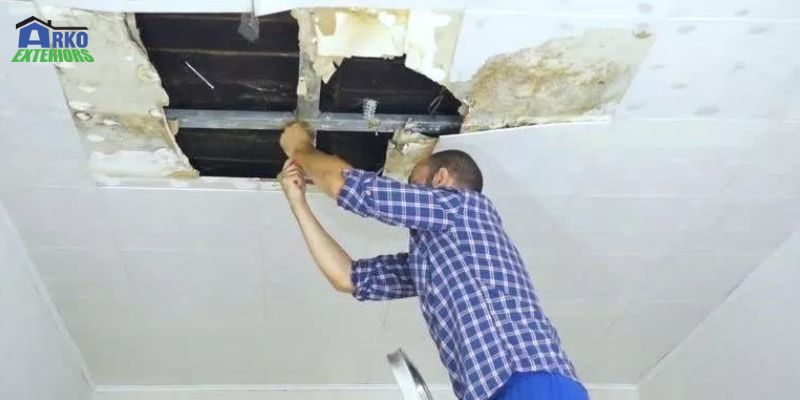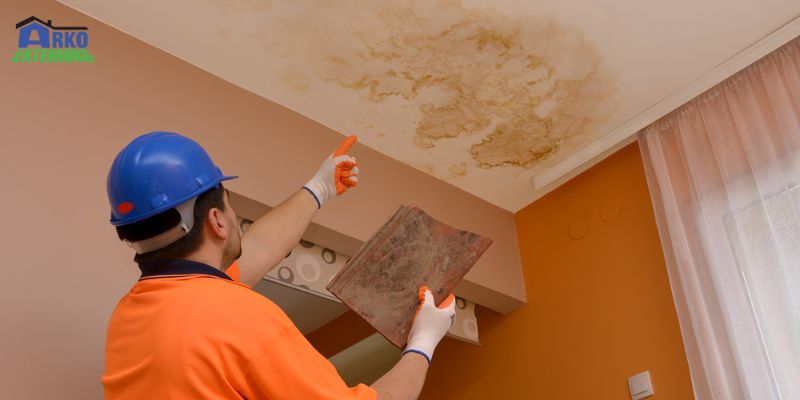Roof Leaks can be a major headache for any homeowner or property manager. Not only do they cause water damage to the structure of the building, but they can also lead to mold growth and other health hazards. However, detecting a roof leak early on can save you from spending thousands of dollars on repairs and prevent any further damage.
What should you look for? Here are some things to consider…
#1 Look For Water Stains On Ceilings & Walls:

One of the most common signs of a roof leak is water stains on your ceilings and walls. These stains may appear as discolored patches or streaks, and they often indicate that water is entering your home through your roof.
If you notice any water stains on your ceilings or walls, it’s essential to take action right away. The longer you wait to address a leak, the more extensive the damage can become, leading to costly repairs and potential health hazards such as mold growth.
#2 Check Your Attic:

Another way to detect a roof leak early is to check your attic for signs of water damage. Look for any wet spots or discoloration on the underside of your roof, as well as on any exposed insulation or rafters.
You may also notice a musty odor in your attic, which can indicate the presence of mold or mildew caused by a roof leak. If you suspect a leak, use a flashlight to carefully inspect your roof for any visible damage, such as missing or damaged shingles, cracks or holes.
By regularly checking your attic and looking for water stains on your ceilings and walls, you can detect roof leaks early and take action to prevent more extensive damage to your home. If you’re unsure about the severity of a leak or how to repair it, it’s best to contact a professional roofing contractor who can assess the issue and provide recommendations for repair or replacement.
#3 Check Your Roof After Severe Weather:
Severe weather events such as storms, heavy rain or strong winds can cause damage to your roof and increase the risk of leaks. After a severe weather event, it’s a good idea to inspect your roof for any visible damage, such as missing or damaged shingles, cracked or curled shingles or debris that may have accumulated on your roof. Be sure to also check your gutters and downspouts for any blockages or damage that could prevent water from draining properly. If you notice any issues, it’s important to address them right away to prevent leaks and other damage.
#4 Look For Signs Of Rust Or Corrosion:
If your roof has any metal components, such as flashing or vent pipes, it’s important to check them regularly for signs of rust or corrosion. Rust and corrosion can weaken these components and create openings that allow water to enter your home.
Inspect these components for any signs of rust, corrosion or other damage, such as cracks or holes. If you notice any issues, it’s important to address them right away to prevent leaks and other damage.
By regularly checking your roof after severe weather, looking for signs of rust or corrosion and addressing any issues promptly, you can detect roof leaks early and prevent more extensive damage to your home.
#5 Check For Missing Or Damaged Shingles:
Missing or damaged shingles can leave your roof vulnerable to water damage and leaks. Check your roof regularly for any shingles that may be missing, cracked or otherwise damaged.
If you notice any issues, it’s important to address them right away. Missing or damaged shingles can be replaced relatively easily by a professional roofing contractor, helping to prevent leaks and further damage to your roof and home.
#6 Inspect Your Chimney & Skylights:
Chimneys and skylights can be particularly vulnerable to leaks, as they often have flashing that can deteriorate over time. Inspect your chimney and skylights regularly for any signs of damage or wear and tear, such as cracked or missing flashing.
If you notice any issues, it’s important to address them right away to prevent water from entering your home. A professional roofing contractor can assess the issue and recommend repair or replacement options, helping to ensure your chimney and skylights are properly sealed and protected against leaks.
Summary:
In conclusion, detecting roof leaks early can save homeowners from dealing with costly repairs later on. By regularly inspecting the roof for any signs of damage, such as missing or damaged shingles, water stains on the ceiling or mold growth, you can catch any potential leaks before they become major problems. Additionally, scheduling regular professional inspections and maintenance can help ensure that your roof stays in good condition and help prevent any leaks from occurring. Remember, early detection is key when it comes to preventing roof leaks and protecting your home.

